Introduction
Heavy Fermion Systems are intermetallic compounds in which local magnetic moments dominate the dynamics of the itinerant electrons. These strong electron correlations result in an increase of the effective mass of the charge carriers up to 100 - 1000 free electron masses at low temperatures.
Examples for Heavy Fermion compounds are:
- CeCu2Si2 (superconducting for T < 0.7K)
- UPt3 (superconducting for T < 0.7K, magnetically ordered for T < 4.5K)
- UPd2Al3 (superconducting for T < 2K, antiferromagnetic for T < 14K)
- . . .
The ground state of heavy fermion systems can be either normalconducting, superconducting or magnetically ordered with or without superconductivity.
The main focus of our current research is on unconventional superconductivity of the heavy fermion compounds UPd2Al3 and UNi2Al3. However, to understand the mechanisms of superconductivity it is also necessary to investigate the normal state of the compounds. Specifically, a detailed knowledge of magnetic and Fermi-surface properties has to be gained.
Our main experimental methodes are transport measurements and tunneling spectroscopy on thin film samples which are prepared by MBE.
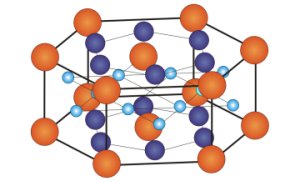
Hexagonal crystal structure of UPd2Al3(red: U, dark blue: Pd, light blue: Al)
Superconductivity of HFS
Unconventional Superconductivity
In the superconducting state the fermionic charge carriers couple to bosonic Cooper-pairs. These Cooper-pairs are all in the same state and are described by a single quantum mechanical wave function. Thus it is not possible for a single charge carrier to change its momentum due to scattering processes which results in current transport without resistivity.
For the formation of the Cooper-pairs an attractive interaction between the negatively charged electrons is necessary. In conventional superconductors (e. g. Pb, Nb, Al, ...) this attractive interaction is due to an interaction of the electrons with the positively charged ions of the crystal lattice (exchange of phonons).
However, in unconventional superconductors there are alternative mechanisms for the Cooper-pair formation. The identification of these mechanisms is one of the main topics of current research. Possible pairing mechanisms are the exchange of magnons, magnetic excitons, charge fluctuations etc. There is strong evidence for unconventional superconductivity in several classes of materials like High Temperature Superconductors, BEDT-TTF based superconductors, Heavy Fermion Superconductors etc.
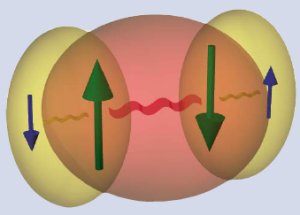
Spin singlet Cooper-pair (blue) coupled by a magnetic mechanism involving localized spins (green).
Current research on Heavy Fermion Systems
Superconductivity of UPd2Al3
Attempts to investigate the superconducting order parameter of heavy-fermion systems by spectroscopic means suffered from degraded superconductivity in the surface region of the examined bulk samples. With the advent of the growth of epitaxial heavy-fermion thin films it is now possible to prepare planar superconductor-insulator-normalconductor (SIN) tunneling junctions entirely in vacuum therefore maintaining clean interfaces. This proved to be essential due to the short superconducting coherence length of these compounds that amounts to about 10nm. For such short coherence length any kind of surface degradation se-verely interferes with the tunneling process. We investigated UPd2Al3, a heavy-fermion system in which superconductivity below Tc=2K coexists with antiferromagnetic order below TN=14.5K. Epitaxial thin films of UPd2Al3 were grown in (0001) orientation on single-crystalline LaAlO3 (111) substrates by molecular beam epitaxy (MBE). Tunneling junctions were obtained by sputtering about 4nm of Al on top of the UPd2Al3 film. The Al was then oxidised in a O2 glow discharge resulting in an insulating tunneling barrier. A four-terminal cross-junction geometry was realised by covering the whole film but a stripe with an insulating layer of about 200nm amorpheous Ge employing a shadow mask technique. This step defined the base electrode. Finally Pb was evaporated through a shadow mask giving the counter-electrode. A schematic of the junction geometry is shown below. Typical junction areas are 0.5x0.3mm2.
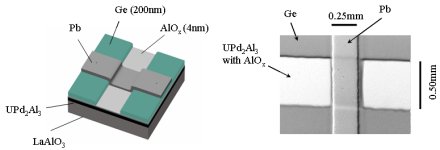
Left: Schematic of a planar tunneling junction. Right: Optical microscope image (phase contrast) of a planar tunneling junction.
The bias-voltage dependent differential conductivity of a superconductor-insulator-nomalcondcutor (SIN) tunneling junction is, in the simplest case, a direct measure of the thermally smeared density of states of the investigated superconductor. In the case of a superconductor-insulator-superconductor (SIS) tunneling junction a folding of the energy-dependent density of states of both electrodes is observed. Strong-coupling superconductivity manifests itself by the appearance of additional structures in the differential conductivity outside the energy gap region. These structures are conventionally due to the coupling of the charge carriers to phonon modes. In the case of UPd2Al3 they could be associated with a magnetic excitation (by comparison with results of inelastic neutron diffraction). This provides strong evidence for an unconventional mechanism of superconductivity based on the exchange of magnetic excitations.
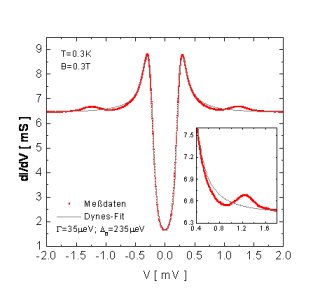
Differential conductivity of a UPd2Al3-AlOx-Pb tunneling junction including stong coupling features.
(M. Jourdan, M. Huth and H. Adrian, Nature 394, 47 (1999).
For the investigation of the energy gap symmetry and comparison with theoretical predictions it would be helpful to measure the magnitude of the gap along crystalographic directions additional to the c-direction shown above. Thus we attempt to grow thin UPd2Al3 film oriented with the crystalographic a-axis perpendicular to the substrate.
Optical conductivity of the heavy fermion compound UPd2Al3
Collaborators:
M. Scheffler, M. Dressel
1. Physikalisches Institut, Universität Stuttgart, D-70550 Stuttgart, Germany
In this projekt thin film samples from Mainz are used for investigation performed at the University of Stuttgart. Additional information is found on the Homepage of Prof. Dressels group, Uni Stuttgart.
The electrical conduction of metals is governed by mobile electrons, more specifically by how freely they can move throughout the material. This movement is hampered by scattering with other electrons as well as with impurities or with thermal excitations (phonons). Experimentally one does not observe the scattering processes of single electrons, but the overall response of all mobile charge carriers within a sample. This ensemble dynamics can be described by relaxation rates: how fast does the system approach equilibrium after an external perturbation? Here we study the heavy-fermion compound UPd2Al3, a metal with strong interaction among the electrons, and show that the precise shape of its frequency-dependent microwave conductivity accurately follows the prediction for a single relaxation rate (the so-called Drude response) although more complex behaviour might be expected. Furthermore the relaxation rate is extremely low, just a few GHz, several orders of magnitude below those of conventional metals (typically around 10 THz) and at least one order of magnitude lower than previously estimated for comparable metals. These observations are directly related to the high effective mass of the charge carriers in this material and reveal the dynamics of interacting electrons.
The heavy fermion superconductor UNi2Al3
For the investigation of unconventional pairing mechanisms of heavy fermion systems the compound UNi2Al3, which is isostructural to UPd2Al3, is of great interest. Whereas UPd2Al3 shows a simple antiferromagnetic structure with relatively large ordered magnetic moments of muord=0.85muB the compound UNi2Al3 is an incommensurately ordered antiferromagnet with smaller ordered moment muord=0.24muB. In contrast to UPd2Al3, for UNi2Al3 there is evidence for a spin-triplet superconducting state (K. Ishida et al., Phys. Rev. Lett. 89, 037002 (2002)). The preparation of the first single crystalline bulk samples of UNi2Al3 (N. Sato et al., J. Phys. Soc. Jpn., 6, 1555 (1996)) was not possible until 5 years after the discovery of superconductivity in this compound (C. Geibel et al., Z. Phys. B, 83, 305 (1991). This is due to metallurgical problems which result in the formation of an UAl2 impurity phase and hence a strongly reduced sample purity compared to UPd2Al3.
We prepared superconducting single crystalline thin films of UNi2Al3 by coevaporation of the elementary components in an MBE-system.
Magnetism of the heavy fermion compound UNi2Al3
Collaborators:
A. Hiess1, T. Charlton2, N. Bernhoeft3, D. Mannix4
1Institut Laue Langevin, BP 156, F-38042 Grenoble Cedex 9, France
2Rutherford Appelton Laboratory, ISIS facility, Chilton, Didcot, Oxfordshire OX11 0QX, UK
3Dept. de Recherche Fond. sur la Matiere Condensee, CEA-Grenoble, F-38054 Grenoble Cedex 9, France
4 XMaS UK CRG beamline, ESRF, BP 220, F-38043 Grenoble Cedex 9, France
The heavy fermion superconductors UPd2Al3 (Tsc = 2K) and UNi2Al3 (Tsc=1K) both exhibit the coexistence of superconductivity and magnetic order at low temperatures. However, they display important differences key to the understanding of the interplay between magnetism and superconductivity, an area of active debate in condensed matter physics. A different unconventional superconducting pairing mechanism may be realized in this compound and the magnetic properties of these samples are crucial to an understanding of the origin of superconductivity.
Resonant magnetic x-ray scattering (XMas UK CGR, ESRF Grenoble) was employed to investigate the magnetic state of epitaxial a* oriented thin films of the heavy fermion superconductor UNi2Al3. The observed incommensurate propagation vector as well as the Neel temperature correspond to those of bulk samples. The 120nm film shows magnetic order with a correlation length > 80nm parallel to the growth axis. Out of the three possible magnetic domains the one with the moment direction perpendicular to the film surface is not realized.
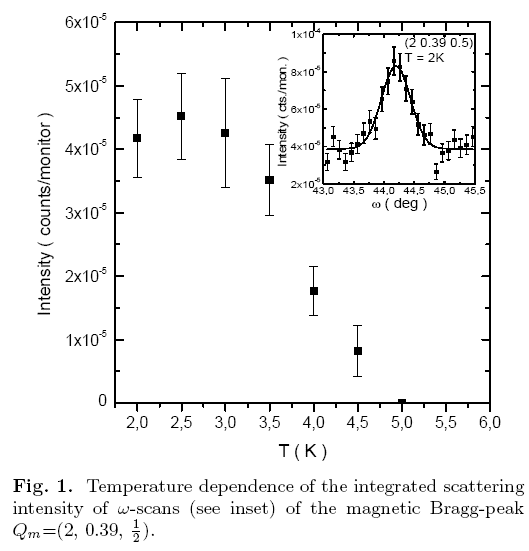
Unconventional superconductivity of the heavy fermion compound UNi2Al3
Any weak attractive electron-electron interaction in metals can cause the formation of Cooper pairs, which then condense into a superconducting ground state. In conventional superconductors this interaction is mediated by lattice vibrations (phonons). However, for heavy fermion superconductors unconventional pairing based on magnetic excitations is favoured. Epitaxial thin films of the heavy fermion superconductor UNi2Al3 (100) were prepared by molecular beam epitaxy (MBE). The elementary components U, Ni and Al are deposited from electron beam evaporators onto heated single crystalline YAlO3 (112) substrates. Resonant magnetic x-ray scattering experiments showed that the magnetic properties of the thin films are very similar to bulk samples. Thus the thin films samples are suitable for the investigation of intrinsic properties of UNi2Al3. By photolithographic pattering of these thin films well defined geometries for the investigation of transport anisotropies are obtained. Directional dependent measurements of the resistivity R(T) give evidence for multiband superconductivity and strongly anisotropic coupling of the intinerant charge carriers to the magnetic order. The temperature dependence of the upper critical field provides an indication of a superconducting spin singlet state in UNi2Al3.
The primary objective of this ongoing project is the direct investigation of the superconducting order parameter and and coupling mechanism of UNi2Al3. The optimization of the barrier properties of planar UNi2Al3-AlOx-Pb,In,Ag junctions is in progress.
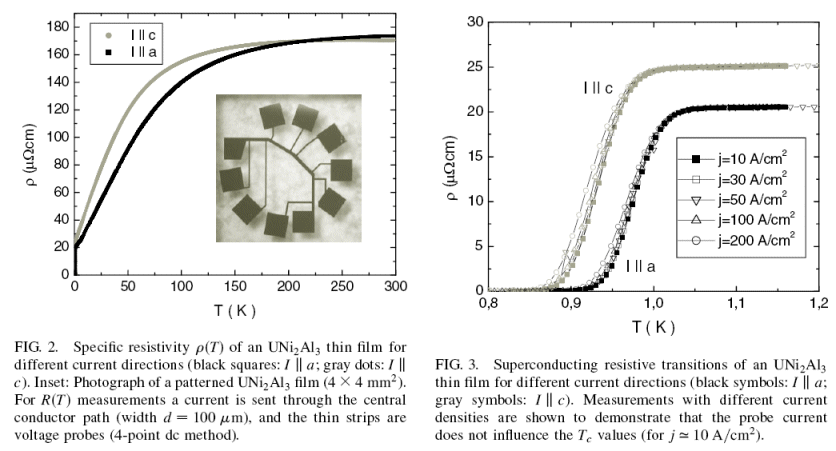
For details please see M. Jourdan et. al. Phys. Rev. Lett. 93, 097001 (2004) or cond-mat/0403634.